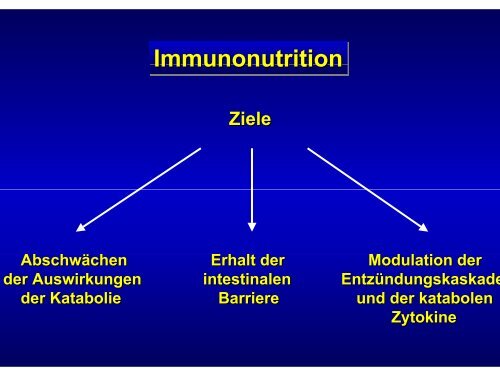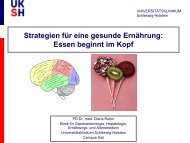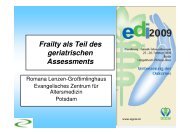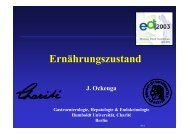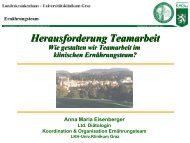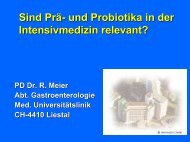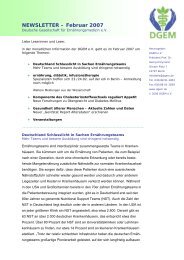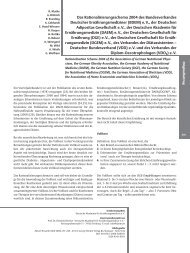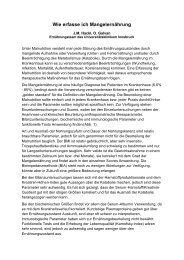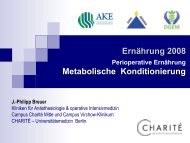Immunonutrition - DGEM
Immunonutrition - DGEM
Immunonutrition - DGEM
Sie wollen auch ein ePaper? Erhöhen Sie die Reichweite Ihrer Titel.
YUMPU macht aus Druck-PDFs automatisch weboptimierte ePaper, die Google liebt.
<strong>Immunonutrition</strong><br />
Ziele<br />
Abschwächen<br />
der Auswirkungen<br />
der Katabolie<br />
Erhalt der Modulation der<br />
intestinalen<br />
Entzündungskaskade<br />
Barriere<br />
und der katabolen<br />
Zytokine
<strong>Immunonutrition</strong><br />
„In general, most of us believe that early<br />
immune-enhanced enteral feeding is<br />
worthwhile when tolerated by the patient.”<br />
Baue et al, Shock 1998; 10: 79 - 89
<strong>Immunonutrition</strong><br />
Fact, Fantasy, , and Future<br />
RL Koretz, Curr Gastroenterol Rep 2002; 4: 332 - 337
... arginine-contraining<br />
immune-enhancing enhancing diet should<br />
not be used in patients with sepsis and their benefit in<br />
other critically ill patients populations remains debatable<br />
Intensive Care Med 2003; 29: 669 - 671
<strong>Immunonutrition</strong><br />
Glutamine<br />
... the addition of glutamine to standard enteral<br />
feeds and the use of immunomodulatory<br />
formulas enhanced with glutamine appeared<br />
to result in higher hospital mortality with little<br />
difference in secondary outcomes.<br />
Saalwachter et al, JPEN 2004; 28 (Abstract)
<strong>Immunonutrition</strong><br />
Effect of glutamine on protection of intestinal epithelial cells<br />
(IEC-18 cells) against lethal heat and oxidant injury via enhanced<br />
expression of heat shock protein 72<br />
Oxidant or<br />
Heat<br />
Injury<br />
GLN<br />
(0-20 mM)<br />
IEC-18<br />
Cells<br />
HSP 72<br />
Cell<br />
Survival<br />
-quercetin<br />
-anti-sense<br />
HSP 72<br />
Oxidant or<br />
Heat<br />
Injury<br />
Cell<br />
Death<br />
Wischmeyer, , PE, Nutrition 2002; 18: 225 - 228
<strong>Immunonutrition</strong><br />
glutamine, glutamate,<br />
cysteine, glycine, , N-acetyl N<br />
cystein<br />
selenium<br />
vitamin E, C, ß-carotineß<br />
carotine,<br />
N-acetyl cysteine, taurine<br />
GSH:GSSG<br />
GSSG<br />
ROS<br />
redox-sensitive<br />
kinases<br />
- +<br />
NFKB<br />
activation<br />
Gene transcription<br />
Inflammation<br />
Roth et al,<br />
Nutrition 2002;<br />
18: 217 - 221
<strong>Immunonutrition</strong><br />
Glutamin<br />
Zellner et al,<br />
Biochim Biophys<br />
Acta 2003;<br />
1638: 138 - 148
<strong>Immunonutrition</strong><br />
Glutamin<br />
Exner et al,<br />
Ann Surg 2003;<br />
237: 110 - 115
<strong>Immunonutrition</strong><br />
Glutamin<br />
Fläring et al,<br />
Clin Sci 2003;<br />
104: 275 - 282
<strong>Immunonutrition</strong><br />
Glutamin<br />
Fläring et al,<br />
Clin Sci 2003;<br />
104: 275 - 282
<strong>Immunonutrition</strong><br />
Omega - 3 - Fettsäuren<br />
Koller et al,<br />
Clin Nutr 2003;<br />
22: 59 - 64
Glutamin<br />
Differences between two means and associated 95% confidence intervals (CI)<br />
for the effect of glutamine on hospital length of stay<br />
Novak et al, Crit Care Med 2002; 30: 2022 - 2029
<strong>Immunonutrition</strong><br />
Glutamin<br />
Goeters et al, Crit Care Med 2002; 30: 2032 - 2037
<strong>Immunonutrition</strong><br />
Glutamine<br />
Fuentes-Orozco<br />
et al, Clin Nutr 2004; 23: 13 - 21
<strong>Immunonutrition</strong><br />
Glutamin<br />
Fuentes-Orozco<br />
et al,<br />
Clin Nutr 2004; 23: 13 - 21
<strong>Immunonutrition</strong><br />
Glutamine<br />
Fuentes-Orozco<br />
et al,<br />
Clin Nutr 2004; 23: 13 - 21
<strong>Immunonutrition</strong><br />
Glutamin<br />
Fuentes-Orozco<br />
et al, Clin Nutr 2004; 23: 13 - 21
Glutamin<br />
Conejero et al, Nutrition 2002; 18: 716-721<br />
721
<strong>Immunonutrition</strong><br />
Zhou et al, JPEN 2003; 27: 241 - 245
<strong>Immunonutrition</strong><br />
Zhou et al, JPEN 2003; 27: 241 - 245
<strong>Immunonutrition</strong><br />
Glutamine PN - effect on mortality<br />
Heyland et al, JPEN 2003; 27: 355 - 373
<strong>Immunonutrition</strong><br />
“ …when PN is prescribed to critically ill<br />
patients, parenteral supplementation<br />
with glutamine, where available, is<br />
recommended. There are insufficient data<br />
to generate recommendations for IV glutamine<br />
in critically ill patients receiving EN. “<br />
Canadian Clinical Practice Guidelines for Nutrition Support<br />
in Mechanically Ventilated Critically Ill Adult Patients<br />
Heyland et al, JPEN 2003; 27: 355-373<br />
373
<strong>Immunonutrition</strong><br />
“ …enteral…<br />
glutamine should be considered<br />
in burn and trauma patients. There are<br />
insufficient data to support the routine<br />
use of enteral glutamine in other<br />
critically ill patients. “<br />
Canadian Clinical Practice Guidelines for Nutrition Support<br />
in Mechanically Ventilated Critically Ill Adult Patients<br />
Heyland et al, JPEN 2003; 27: 355-373<br />
373
Enterale <strong>Immunonutrition</strong><br />
Metaanalysen<br />
• Heys et al, Ann Surg 1999; 229: 467 - 477<br />
• Beale et al, Crit Care Med 1999; 27: 2799 - 2805<br />
• Heyland et al, JAMA 2001; 286: 944 - 953<br />
• Montejo et al, Clin Nutr 2003; 22: 221-223<br />
223<br />
• Heyland et al, JPEN 2003; 27: 355-373<br />
373<br />
• Correia et al, 2004 in press
Enterale <strong>Immunonutrition</strong><br />
Metaanalyse<br />
Heyland et al, JAMA 2001; 286: 944 - 953
Enterale <strong>Immunonutrition</strong><br />
Metaanalyse<br />
Heyland et al, JAMA 2001; 286: 944 - 953
<strong>Immunonutrition</strong><br />
Gianotti et al, Gastroenterology 2002; 122: 1763 - 1770
<strong>Immunonutrition</strong><br />
Effect of Pharmaconutrition on mortality<br />
Montejo et al,<br />
Clin Nutr 2003; 22: 221 - 233
<strong>Immunonutrition</strong><br />
Bertolini et al, Intensive Care Med 2003; 29: 834 - 840
<strong>Immunonutrition</strong><br />
Arginine containing IED - effect on mortality<br />
Heyland et al, JPEN 2003; 27: 355 - 373
<strong>Immunonutrition</strong><br />
“…we recommend that diets supplemented<br />
with arginine and other select nutrients<br />
not be used for critically ill patients. “<br />
Canadian Clinical Practice Guidelines for Nutrition Support<br />
in Mechanically Ventilated Critically Ill Adult Patients<br />
Heyland et al, JPEN 2003; 27: 355-373<br />
373
Arginin<br />
<strong>Immunonutrition</strong><br />
Sepsis<br />
• möglicherweise reduzierte Aufnahme<br />
im Intestinum<br />
• eventuell Verstärkung des septischen<br />
Schocks durch NO
<strong>Immunonutrition</strong><br />
Arginin<br />
Preiser et al,<br />
JPEN 2001;<br />
25: 182 - 187
<strong>Immunonutrition</strong><br />
Sepsis<br />
Omega - 3 - Fettsäuren<br />
• in der Hyperinflammation möglicherweise<br />
protektive Wirkung<br />
→ TNFα ↓ und IL-1 ↓<br />
• Spätphase mit Hypoinflammation und<br />
Immunsuppression möglicherweise<br />
m<br />
ungünstig<br />
nstig
<strong>Immunonutrition</strong><br />
Dysfunctional inflammatory response<br />
Severe<br />
SIRS<br />
Early MOV<br />
Trauma<br />
Moderate SIRS<br />
Moderate Immunsuppression<br />
•Tissue Injury<br />
•Shock<br />
•Host Factors<br />
• Second Hits<br />
Severe<br />
Immunsuppression<br />
Infections Late MOV<br />
F.A. Moore, Crit Care Med 1999; 27: 674 - 675
<strong>Immunonutrition</strong><br />
ARDS<br />
Gadek et al, Crit Care Med 1999; 27: 1409 - 1420
<strong>Immunonutrition</strong><br />
“Further research needs to define the<br />
underlying mechanism by which<br />
immunonutrition may be harmful ... “<br />
Heyland et al, JAMA 2001; 286: 944 - 953
<strong>Immunonutrition</strong><br />
McNaught et al, Gut 2002; 51: 827 - 831
Ökoimmunonutrition<br />
Rayes et al, Nutrition 2002; 18: 609 - 615
<strong>Immunonutrition</strong><br />
Benefits of early enteral nutrition with glutamine and<br />
probiotics in brain injury patients<br />
variable<br />
control group<br />
study group<br />
(n = 10) (n = 10)<br />
p<br />
number of infections/<br />
patient 3 ( 1 - 5 ) 1 ( 0 - 3 ) < 0.01<br />
ICU stay (days) 22 ( 2 - 57 ) 10 ( 5 - 20 ) < 0.01<br />
mechanical ventilation<br />
(days) 14 ( 3 - 53 ) 7 ( 1 - 15 ) 0.04<br />
Falcao de Arruda IS, Aguilar-Nascimento JE, Clin Sci 2004; 106: 287 - 292
<strong>Immunonutrition</strong><br />
Safety of immunonutrition in liver transplantation (LT)<br />
and effects on nutritional status<br />
Plank et al, Clin Nutr 2001; 20 (Suppl(<br />
3): 18<br />
Ergebnisse: • keine Toleranzprobleme, sicher<br />
• TBP<br />
Test<br />
Kontrolle<br />
präop<br />
op. Anstieg um 0.42 ± 0.15 kg ±<br />
(p=0.017)<br />
postop. 0.71 ± 0.24 kg Verlust 0.92 ± 0.10 kg Verlust<br />
in den ersten 15 Tagen<br />
nur 40 % Ausgleich<br />
(p=0.026) - Ausgleich<br />
nach 180 Tagen<br />
nach 180 Tagen<br />
• infektiöse Komplikationen<br />
Test 5 / 15 vs Kontrolle 21 / 36<br />
Schlußfolgerungen:<br />
Mögliche Vorteile einer <strong>Immunonutrition</strong> zur Verbesserung<br />
des präop<br />
op. . Ernährungsstatus, der Erholung nach LTX und<br />
der Reduktion von Komplikationen bedürfen Klärung<br />
durch PRCT
Antioxidanzien<br />
Nathens et al, Ann Surg 2002; 236: 814 - 822
<strong>DGEM</strong>-Leitlinie<br />
Enterale Ernährung<br />
Chirurgie und Transplantation<br />
Immunmodulierende enterale Diäten<br />
(Arginin,, Omega-3-Fettsäuren<br />
Fettsäuren, Ribonukleotide)<br />
Indikationen (A):<br />
• Ösophagusresektion<br />
• Gastrektomie<br />
• Duodenopankreatektomie<br />
• schweres Polytrauma<br />
• halschirurgische Tumoroperationen<br />
prä- und postoperativ für f r 5 - 7 Tage (C)<br />
Weimann et al, Aktuel Ernaehr Med 2003; Suppl 1: S51-S60<br />
S60
<strong>DGEM</strong>-Leitlinienentwurf<br />
Parenterale Ernährung<br />
Chirurgie und Transplantation<br />
„Postoperativ sieht die Arbeitsgruppe die Indikation<br />
zur parenteralen Gabe von Glutamin-Dipeptidlösungen<br />
derzeit nur für schwer mangelernährte Patienten,<br />
die enteral nicht adäquat ernährbar einer parenteralen<br />
Ernährung bedürfen.<br />
Die aktuelle Studienlage reicht für eine generelle<br />
Empfehlung zum parenteralen Einsatz von Glutamin<br />
in der Chirurgie nicht aus (C).“
<strong>Immunonutrition</strong><br />
Zusammenfassung<br />
• Wirkmechanismen bedürfen weiterer Abklärung<br />
• klinischer Nutzen nach Evidenz-basierten Kriterien<br />
belegt<br />
- wahrscheinlich „sicher“ auch nach<br />
Organtransplantation<br />
• Empfehlung des Einsatzes enteraler Kombinationen<br />
in Leitlinien der <strong>DGEM</strong><br />
Einschränkungen nkungen beim kritisch Kranken - Sepsis<br />
• Entwicklung eines „Bedside“ Immunmonitoring<br />
erforderlich
<strong>Immunonutrition</strong><br />
Zukünftige Studien<br />
• Fokus oral /enteral/<br />
- Präkonditionierung<br />
• kritisch Kranke: kombiniert enteral / parenteral
<strong>Immunonutrition</strong><br />
Klinische Studien<br />
• Qualitätsverbesserung<br />
tsverbesserung<br />
• Definition des kritisch Kranken (APACHE)<br />
• Outcomeparameter - multizentrisch (KKS)<br />
• Intensivmedizin auch Surrogatparameter<br />
- Composite Score (MOF)<br />
- Immunsystem (HLA-DR auf Monozyten)<br />
- Mobilität t (Griffstärke)<br />
rke)<br />
• Ökonomie<br />
- Ressourcenverbrauch
<strong>Immunonutrition</strong><br />
Evidenz<br />
Ökonomie<br />
Dilemma der evidenzbasierten Medizin ?
<strong>Immunonutrition</strong><br />
Trotz hohem Impact-Faktor ist der<br />
Impakt von IMPACT auf die<br />
perioperative Ernährung bisher<br />
limitiert.
<strong>Immunonutrition</strong><br />
Glutamin<br />
Zellner et al, Biochim Biophys Acta 2003; 1638: 138 - 148
<strong>Immunonutrition</strong><br />
Glutamin<br />
Exner et al,<br />
Ann Surg 2003;<br />
237: 110 - 115
<strong>Immunonutrition</strong><br />
Safety of immunonutrition in liver transplantation (LT)<br />
and effects on nutritional status<br />
Plank et al, Clin Nutr 2001; 20 (Suppl(<br />
3): 18<br />
Fragestellung:<br />
Sicherheit einer enteralen <strong>Immunonutrition</strong> bei Patienten<br />
vor und nach Lebertransplantation, Einfluß auf<br />
Ernährungsstatus, gemessen am Gesamtkörperprotein (TBP<br />
Patienten und Methoden:<br />
• 15 Pat. erhielten 0,5 l/d Oral IMPACT ® während<br />
der Wartezeit Median 54 (Range 10 - 168) Tage<br />
und enteral für f r mindestens 5 Tage nach LTX<br />
• Bestimmung des TBP durch Messung der<br />
Neutronenaktivierung vor, 15 und 180 Tage<br />
nach LTX<br />
• Vergleich mit 36 Pat. ohne <strong>Immunonutrition</strong>,<br />
14 mit TBP-Bestimmung<br />
Bestimmung
Enterale <strong>Immunonutrition</strong><br />
Metaanalyse<br />
Heyland et al, JAMA 2001; 286: 944 - 953
<strong>Immunonutrition</strong><br />
Nosocomial infections in ICU stay<br />
Type<br />
PH<br />
Impact<br />
Bacteremia 19 7<br />
Urinary tract infection 13 11<br />
Pneumonia 11 11<br />
Tracheobronchitis 11 10<br />
Catheter-related related infection 5 4<br />
Soft tissue infection 1 1<br />
Other 8 2<br />
ICU, intensive care unit;<br />
PH, Precitene Hiperproteico<br />
Galbán et al, Crit Care Med 2000; 28: 643 - 648
<strong>Immunonutrition</strong><br />
Senkal et al, Arch Surg 1999; 134: 1309 - 1316<br />
Outcome and Cost-effectiveness of Perioperative Enteral<br />
<strong>Immunonutrition</strong> in Patients Undergoing Effective upper<br />
Gastrointestinal Tract Surgery * p
Antioxidanzien<br />
• Vitamin E, C<br />
• Glutathion<br />
• β-Caroten<br />
verminderte Zellschädigung<br />
Freisetzung von proinflammatorischen<br />
Zytokinen ↓
Antioxidanzien<br />
beim kritisch Kranken:<br />
reduzierte antioxidative Kapazität<br />
• niedrige Serumspiegel von α-Tocopherol<br />
und Vitamin C<br />
Metulitz et al, Intensive Care Med 1999; 25: 180 - 185<br />
Borrelli et al, Crit Care Med 1996; 24: 392 - 397<br />
Schorah et al, Am J Clin Nutr 1996; 63: 760 - 765<br />
• Erhöhung hung des oxidierten Glutathions in der<br />
Alveolarflüssigkeit<br />
Bunnell et al, Am Rev Respir Dis 1993; 148: 1174 - 1178
<strong>Immunonutrition</strong><br />
McNaught et al,<br />
Gut 2002; 51: 827 - 831
<strong>Immunonutrition</strong><br />
McNaught et al, Gut 2002; 51: 827 - 831
<strong>Immunonutrition</strong><br />
Johnson et al, Ann Surg 2003; 237: 565 - 573
<strong>Immunonutrition</strong><br />
Johnson et al,<br />
Ann Surg 2003; 237: 565 - 573
<strong>Immunonutrition</strong><br />
Johnson et al, Ann Surg 2003; 237: 565 - 573
<strong>Immunonutrition</strong><br />
Coopersmith CM et al,<br />
JAMA 2002; 287: 1716 - 1721
Antioxidanzien<br />
Nathens et al, Ann Surg 2002; 236: 814 - 822
Antioxidanzien<br />
Nathens et al, Ann Surg 2002; 236: 814 - 822
Antioxidanzien<br />
Nathens et al, Ann Surg 2002; 236: 814 - 822
Antioxidanzien<br />
Preiser et al, Crit Care Med 2000; 28: 3828 - 3832
<strong>Immunonutrition</strong><br />
Bertolini et al, Intensive Care Med 2003; 29: 834 - 840
<strong>Immunonutrition</strong><br />
Lobo et al, Lancet 2002; 359: 1812 - 1818
<strong>Immunonutrition</strong><br />
Lobo et al, Lancet 2002; 359: 1812 - 1818
<strong>Immunonutrition</strong><br />
Zhou et al, JPEN 2003; 27: 241 - 245
<strong>Immunonutrition</strong><br />
Zhou et al, JPEN 2003; 27: 241 - 245
<strong>Immunonutrition</strong><br />
Glutamine supplemented enteral nutrition<br />
after severe trauma<br />
Houdijk et al, Lancet 1998; 352: 772 - 776<br />
Fragestellung:<br />
Einfluß auf infektiöse Komplikationen<br />
Patienten und Methoden: n = 72 ; Prospektiv, kontrolliert, randomisier<br />
Patienten nach schwerem Trauma (ISS > 20)<br />
enterale Ernährung mit Glutamin<br />
(30.5 g/ 100 g Protein)<br />
vs. Isonitrogene, isokalorische Kontrolle über<br />
5 Tage über nasoduodenale Sonde
<strong>Immunonutrition</strong><br />
Metaanalysis<br />
Beale et al, Crit Care Med 1999; 27: 2799 - 2805
Effect of preoperative oral immune-enhancing enhancing nutritional supplement on<br />
patients at high risk of infection after cardiac surgery:<br />
a randomized placebo - controlled trial<br />
Tepaske et al, Lancet 2001; 358: 696 - 701<br />
Fragestellung: Verbesserung der präoperativen Immunabwehr zur Senkung<br />
der postoperativen Komplikationen und Organdysfunktion<br />
vor elektiven Herzoperationen<br />
Patienten und Methoden:<br />
PRCT - Doppelblind, Placebokontrolliert<br />
• n = 50, > 70 Jahre oder älter, EF < 0.4 vor MKE<br />
• Randomisierung für r ein orales immunmodulierendes<br />
Supplement (Arginin, Omega-3-Fetts<br />
Fettsäuren, RNA)<br />
oder Kontrolle für f r minimal 5 Tage<br />
• Endpunkte: verzögerte Immunantwort (Multitest Mérieux),<br />
HLA-DR<br />
DR-Expression auf Monozyten,<br />
IL-6-Plasma<br />
Plasma-Konzentration<br />
• Analyse per Protokoll<br />
<strong>Immunonutrition</strong>
<strong>Immunonutrition</strong><br />
Effect of preoperative oral immune-enhancing enhancing nutritional supplement on<br />
patients at high risk of infection after cardiac surgery:<br />
a randomized placebo - controlled trial<br />
Tepaske et al, Lancet 2001; 358: 696 - 701<br />
Ergebnisse: • 5 Pat. ausgeschlossen - weniger als minimale Menge von 5 l<br />
Trinklösung<br />
Testgruppe:<br />
• präop<br />
op. . Expression von HLA-DR auf Monozyten signifikant<br />
höher her (p = 0.02)<br />
• IL-6-Konzentration signifikant niedriger (p = 0.032)<br />
• verzögerte Immunantwort verbessert und anhaltend bis zur<br />
Entlassung<br />
Schlußfolgerung:<br />
Die Einnahme von oralen immunmodulierenden<br />
Supplementen für f r 5 Tage kann bei high-Risk<br />
Risk-Patienten<br />
mit elektiven kardiochirurgischen Eingriffen zur<br />
Verbesserung des Outcome führen
<strong>Immunonutrition</strong><br />
Frage:<br />
Antwort:<br />
Wann besteht die Indikation zum Einsatz von<br />
immunmodulierenden Substraten ?<br />
Der Einsatz von enteralen mit<br />
immunmodulierenden Substraten (Arginin,<br />
Omega-3-Fettsäuren und Ribonukleotiden)<br />
supplementierten Diäten wird für die<br />
obengenannten Patientengruppen empfohlen (A).<br />
Die Arbeitsgruppe schließt sich dem<br />
US-Summit<br />
Summit-Konsensus<br />
zur <strong>Immunonutrition</strong> an.<br />
<strong>DGEM</strong>-Leitlinien 2002
<strong>Immunonutrition</strong><br />
Nutritional Approach in Malnourished Surgical Patients<br />
Braga et al, Arch Surg 2002; 137: 174 - 180<br />
Fragestellung: Einfluß einer enteralen <strong>Immunonutrition</strong> auf die<br />
postoperative Morbidität<br />
Patienten und Methoden: Patienten mit Gewichtsverlust > 10 %<br />
vor großen visceralchirurgischen<br />
Operationen<br />
PRCT n = 150<br />
Ernährung:<br />
• postoperativ standard enteral (n=50)<br />
• präop<br />
op. . 7 Tage 1 l/d Trinklösung<br />
mit Arginin, Omega-3-Fetts<br />
Fettsäuren<br />
und RNA, postop. . Standard enteral<br />
(n=50)<br />
• präop<br />
op. . 7 Tage 1 l/d immunmodulierende<br />
Trinklösung,<br />
postop. Immunmodu-<br />
lierende Diät (n=50)
<strong>Immunonutrition</strong><br />
Conejero et al, Nutrition 2002; 18: 716-721<br />
721
<strong>Immunonutrition</strong><br />
Conejero et al, Nutrition 2002; 18: 716-721<br />
721
<strong>Immunonutrition</strong><br />
Preoperative Characteristics and Comorbidity Factors of 150 Participants*<br />
Variable<br />
Control<br />
Group<br />
(n=50)<br />
Preoperative<br />
Group<br />
(n=50)<br />
Perioperative<br />
Group<br />
(n=50)<br />
Age, Y 65.5 (12.4) 65.9 (12.6) 64.1 (12.8)<br />
Sex, M:F, No. 28:22 30:20 26:24<br />
Body weight, kg 59.8 (10.1) 60.2 (9.2) 58.7 (8.8)<br />
Weight loss % 13.1 (3.6) 12.9 (1.5) 2.6 (1.8)<br />
Anesthesiologists score<br />
Karnofsky score 81 (13) 82 (8) 78 (14)<br />
Hemoglobin, g/dl 11.8 (1.6) 11.9 (1.7) 11.7 (1.9)<br />
Total proteins, g/dl 6.3 (0.7) 6.2 (0.7) 6.4 (0.5)<br />
Albumin, g/dl 3.5 (0.8) 3.4 (0.6) 3.4 (0.8)<br />
Prealbumin, g/dl 1.6 (1.1) 1.7 (0.9) 2.0 (1.0)<br />
Retinal binding protein, g/l 0.032 (0.016) 0.033 (0.016) 0.034 (0.019)<br />
Total lymphocyte count, /µl 1510 (530) 1470 (560) 1490 (650)<br />
Creatinine, mg/dl † 0.77 (0.23) 0.72 (0.19) 0.73 (0.12)<br />
Arginine, mg/dl ‡ 1.12 (0.15) 1.09 (0.17) 1.11 (0.16)<br />
Data are given as mean (SD), except where indicated otherwise<br />
To convert creatinine from milligrams per deciliter to the SI unit micromoles per liter, multiply milligrams per deciliter by 88.4<br />
To convert arginine from milligrams per deciliter to the SI unit micromoles per liter, multiply milligrams per deciliter by 57.4<br />
Braga et al, Arch Surg 2002; 137: 174 - 180
<strong>Immunonutrition</strong><br />
Mean nutritional intake in the first 7 days<br />
PH<br />
Impact<br />
Variable µ ± σ µ ± σ p<br />
kcal/day 1313 ± 471 1231 ± 411 .004<br />
Nitrogen/day, g 12.3± 4.1 13.3 ± 4.4 .13<br />
PH, Precitene Hiperproteico<br />
Galbán et al, Crit Care Med 2000; 28: 643 - 648
<strong>Immunonutrition</strong><br />
Surgical Variables in 150 Participents<br />
Variable<br />
Control<br />
Group<br />
(n=50)<br />
Preoperative<br />
Group<br />
(n=50)<br />
Perioperative<br />
Group<br />
(n=50)<br />
Gastric resection, No. 19 19 18<br />
Pancreatic resection, No. 16 20 21<br />
Colorectal resection, No. 11 8 10<br />
Esophagial resection, No. 2 3 1<br />
Operative time, 244 (110) 258 (90) 263 (97)<br />
mean (SD), min.<br />
Operative blood loss, 452 (339) 485 (312) 493 (291)<br />
mean (SD), ml<br />
Transfused patients, No. 17 16 18<br />
Transfusion, mean (SD), ml 555 (310) 570 (255) 480 (190)<br />
Braga et al, Arch Surg 2002; 137: 174 - 180
<strong>Immunonutrition</strong><br />
Outcome Variables<br />
Variable<br />
Control<br />
Group<br />
(n=50)<br />
Preoperative<br />
Group<br />
(n=50)<br />
Perioperative<br />
Group<br />
(n=50)<br />
Patients with major<br />
complications, No. 12 9 6<br />
Patients with infectious<br />
complications, No. 12 8 5<br />
Patients with noninfectious<br />
complications, No. 11 10 6<br />
Patients with complications,<br />
total No. 21 14 9*<br />
Length of hospital stay,<br />
mean (SD),d 15.3 (4.1) 13.2 (3.5)† 12.0 (3.8) ‡<br />
* p = .02 vs the control group<br />
†p = .01 vs the control group<br />
‡p = .04 vs the preoperative group and p = .001 vs the control group<br />
Braga et al, Arch Surg 2002; 137: 174 - 180
<strong>Immunonutrition</strong><br />
Mortality as a function of APACHE II score and feed<br />
APACHE II<br />
Relative Risk<br />
Score PH Impact (95% CI) p<br />
10 - 15 8/29 = 27.6% 1/26 = 3.8% 0.10 (0.01 - 0.87) .02<br />
16 - 20 10/38 = 26.3% 7/41 = 17.1% 0.58 (0.19 - 1.71) .32<br />
21 - 25 6/11 = 56.5% 4/12 = 33.3% 0.42 (0.08 - 2.25) .31<br />
25 + 4/ 9 = 44.4% 5/10 = 50.0% 1.25 (0.20 - 7.61) .81<br />
APACHE, Acute Physiology and Chronic Health Evaluation;<br />
PH, Precitene Hiperproteico;<br />
CI, confidence interval<br />
Galbán et al, Crit Care Med 2000; 28: 643 - 648
The critical elements of acute<br />
inflammation are not the<br />
individual proinflammatory and<br />
anti-inflammatory inflammatory mediators,<br />
but the consequences of their<br />
interactions in concert.<br />
J. C. Marshall, Crit Care Med 2000; 28; 2646 - 2648
Antioxidanzien<br />
Angstwurm et al, Crit Care Med 1999; 27: 1807 - 1813
Antioxidanzien<br />
Nathens et al, Ann Surg 2002; 236: 814 - 822
Antioxidanzien<br />
Nathens et al, Ann Surg 2002; 236: 814 - 822
Antioxidanzien<br />
Nathens et al, Ann Surg 2002; 236: 814 - 822
Antioxidanzien<br />
Nathens et al, Ann Surg 2002; 236: 814 - 822
<strong>Immunonutrition</strong><br />
“The right stuff at the right time<br />
in the right place”<br />
Romand JA, Suter PM, Crit Care Med 2000; 28: 2671 - 2672
Antioxidanzien<br />
Nathens et al, Ann Surg 2002; 236: 814 - 822
Antioxidanzien<br />
Preiser et al, Crit Care Med 2000; 28: 3828 - 3832
<strong>Immunonutrition</strong><br />
Consensus Recommendations From the U.S. Summit<br />
on Immune-Enhancing<br />
Enteral Therapy<br />
V. Zeitpunkt des Beginns<br />
A. • wenn möglich m<br />
5 - 7 Tage präoperativ<br />
• sofern notwendig Schaffung eines enteralen Zugangs<br />
• Beginn zum klinisch sicheren Zeitpunkt<br />
VI. Dosis<br />
• Steigerung nach Toleranz<br />
• mindestens 1200 - 1500 ml/d oder bis mindestens 50 - 60 %<br />
des Energiebedarfs<br />
JPEN 2001; 25: 561 - 562
<strong>Immunonutrition</strong><br />
Consensus Recommendations From the U.S. Summit<br />
on Immune-Enhancing<br />
Enteral Therapy<br />
I. Geeignete Indikationen:<br />
A. Patienten mit elektiven gastrointestinalen Eingriffen<br />
1. oberer GI-Trakt<br />
mäßig oder schwer mangelernährt (Albumin < 3.5 g/dl)<br />
2. unterer GI-Trakt<br />
schwer mangelernährt (Albumin < 2.8 g/dl)<br />
B. Patienten mit stumpfem und penetrierendem Torsotrauma<br />
1. Injury Severity Score (ISS) ≥ 18<br />
2. Abdominal Trauma Index (ATI) ≥ 20<br />
JPEN 2001; 25: 561 - 562
<strong>Immunonutrition</strong><br />
Consensus Recommendations From the U.S. Summit<br />
on Immune-Enhancing<br />
Enteral Therapy<br />
II.<br />
Wahrscheinlich geeignete Indikationen:<br />
(weitere Studien erforderlich)<br />
A. Elektive große Operationen<br />
1. Aorta mit bestehender COPD<br />
2. Kopf und Hals bei vorbestehender Mangelernährung<br />
B. Schweres Schädel-Hirn<br />
Hirn-Trauma<br />
(Glasgow Coma Scale < 8 bei patholog. . CT<br />
C. Verbrennungen ≥ 30 %<br />
D. internistische und chirurgische Beatmungspatienten ohne<br />
Sepsis mit Risiko für f r Infektionen<br />
JPEN 2001; 25: 561 - 562
III.<br />
<strong>Immunonutrition</strong><br />
Consensus Recommendations From the U.S. Summit<br />
on Immune-Enhancing<br />
Enteral Therapy<br />
Nutzen nicht bewiesen:<br />
Patienten mit schwerer Sepsis -<br />
(möglicherweise erhöhte Letalität)<br />
IV. Nicht geeignete Indikationen:<br />
A. Orale Nahrungsaufnahme ad libitum innerhalb von 5 Tagen möglich<br />
B. Intensivpatienten nur zum Monitoring<br />
C. Darmobstruktion distal des enteralen Zugangs<br />
D. Schockzustand oder Hypoperfusion im Splanchnikusgebiet<br />
E. obere GI-Blutung bei Ösophagusvarizen<br />
oder Ulkus mit<br />
endoskopisch darstellbarem Gefäß<br />
JPEN 2001; 25: 561 - 562
<strong>Immunonutrition</strong><br />
Mortality as a function of APACHE II score and feed<br />
15<br />
10<br />
PH<br />
Impact<br />
5<br />
0<br />
10 - 15 16 - 20 21 - 24 25 +<br />
APACHE II Score<br />
Galbán et al, Crit Care Med 2000; 28: 643 - 648
<strong>Immunonutrition</strong><br />
Clinical results of trial<br />
PH Impact<br />
Result µ ± σ µ ± σ p<br />
Mortality rate 28/87 = 32.2% 17/89 = 19.1% .05<br />
Mortality rate<br />
(APACHE II = 10-15) 15) 8/29 = 27.6% 1/26 = 3.8% .02<br />
Patients with bacteremias 19/87 = 21.8% 7/89 = 7.9% .01<br />
>1 nosocomial infection 17/87 = 19.5% 5/89 = 5.6% .01<br />
Length of stay, days 16.6 ± 12.9 18.2 ± 12.6 .41<br />
Ventilator days 12.2 ± 10.3 12.4 ± 10.4 .90<br />
PH, Precitene Hiperproteico;<br />
APACHE, Acute Physiology and Chronic Health Evaluation<br />
Galbán et al, Crit Care Med 2000; 28: 643 - 648
<strong>Immunonutrition</strong><br />
Glutamine supplemented enteral nutrition<br />
after severe trauma<br />
Houdijk et al, Lancet 1998; 352: 772 - 776<br />
Ergebnisse: n = 60<br />
Glutamingruppe n = 31<br />
Kontrollgruppe n = 29<br />
• Pneumonie 5 (17%) vs 14 (45%) p < 0.02<br />
• Bakteriämie 2 ( 7%) vs 13 (42%) p < 0.005<br />
• Sepsis 1 (3.5%) vs 8 (26%) p < 0.02<br />
Schlußfolgerung: weniger infektiöse Komplikationen
<strong>Immunonutrition</strong><br />
Glutamin in der parenteralen Ernährung<br />
Literaturübersicht randomisierter kontrollierter Studien<br />
Autor Jahr Patientengut n Ergebnis<br />
Stehle et al 1989 visceralchirurgisch 12 +<br />
Hammarqvist et al 1989 visceralchirurgisch 22 +<br />
Scheltinga et al 1991 hämatologisch 20 +<br />
Ziegler et al 1992 hämatologisch 45 ++<br />
Schloerb et al 1993 hämatologisch 29 ++<br />
van der Hulst et al 1993 visceralchirurgisch 20 +<br />
van Zaanen et al 1994 hämatologisch 20 +-<br />
O‘Riordain et al 1994 visceralchirurgisch 20 +<br />
Tremel et al 1994 internist.Intensivpat. 12 +<br />
Griffiths et al 1997 Intensivpatienten 84 ++<br />
Morlion et al 1998 visceralchirurgisch 28 ++<br />
Schloerb u.Skinne 1999 hämatol. Onkologie 66 +-<br />
Powell-Tuck et al 1999 Indik. zur TPN auch 168 +<br />
visceralchirurgisch<br />
Fürst 1999 visceral- und 126 ++<br />
thoraxchirurgisch
<strong>Immunonutrition</strong><br />
Senkal et al, Arch Surg 1999; 134: 1309 - 1316<br />
Test<br />
Control<br />
n<br />
no. of infections<br />
complications<br />
costs (DM) of<br />
complications<br />
78 76<br />
14 27 *<br />
75 173 204 241<br />
Outcome and Cost-effectiveness of Perioperative Enteral <strong>Immunonutrition</strong><br />
in Patients Undergoing Effective upper Gastrointestinal Tract Surgery<br />
* p= 0.05
<strong>Immunonutrition</strong><br />
Omega-3-Fettsäuren<br />
• antininflammatorische Eigenschaften<br />
• Stimulation der Bildung inflammatorisch weniger<br />
wirksamer Prostaglandine und Leukotriene<br />
• Verbesserung der T-Zell Funktion<br />
• Aktivierung natürlicher Killerzellen<br />
• Aktivierung von Makrophagen
<strong>Immunonutrition</strong><br />
Arginin<br />
• bedingt essentielle Aminosäure während<br />
Stress and Katabolie<br />
• Aktivierung natürlicher Killerzellen<br />
• Steigerung der Mitogenese von Lymphozyten und<br />
Toxizität von Makrophagen<br />
• steigert intestinale Synthese von Polyaminen<br />
• Stickstofflieferant zur Bildung von NO
Enterale <strong>Immunonutrition</strong><br />
Metaanalyse<br />
Heyland et al, JAMA 2001; 286: 944 - 953
Glutamin<br />
in vitro<br />
und<br />
Tierexperimente<br />
klinisch<br />
Proteinsynthese ↑<br />
T-Zellaktivierung<br />
IL-2 ↑<br />
IL-1 ↑<br />
Hydratationszustand<br />
der Zelle ↑<br />
Anabolie<br />
Stickstoffbilanz ↑<br />
Mukosaatrophie ↓<br />
Cysteinyl-Leukotrien-Synthese<br />
durch PMN ↑<br />
Infektionsrate ↓<br />
Hospitalisierung ↓<br />
Letalität nach 6 Monaten ↓
<strong>Immunonutrition</strong><br />
Nutritional Approach in Malnourished Surgical Patients<br />
Braga et al, Arch Surg 2002; 137: 174 - 180<br />
Ergebnisse: Intent-to<br />
to-treat treat Analyse:<br />
• Pat. mit Komplikationen signifikant niedriger in der<br />
perioperativen Gruppe als in der Standardgruppe<br />
(9 vs 24 - p < 0,02)<br />
• Hospitalliegedauer signifikant niedriger in der<br />
präoperativen<br />
(13,2 Tage - p > 0,01) und perioperativen<br />
(12,0 Tage - p < 0,01) Gruppe als in der Standard-<br />
gruppe (15,3 Tage)<br />
Schlußfolgerung:<br />
Für r mangelernährte Patienten ist eine<br />
perioperative <strong>Immunonutrition</strong> besonders<br />
günstig.
<strong>Immunonutrition</strong><br />
ARDS<br />
Gadek et al, Crit Care Med 1999; 27: 1409 - 1420
<strong>Immunonutrition</strong><br />
Jejunal application of immunemodulating supplement<br />
in patients with severe acute pancreatitis – preliminary<br />
results<br />
Scheppach et al, Clin Nutr 2003; 22 (Suppl(<br />
1): S32<br />
Einleitung: Sicherheit und Toleranz,, Antiinflammmation durch<br />
enterales Supplement mit Glutamin, Tributyrin, , Vitamin C/E,<br />
ß-Caroten, , Zink und Selen (Intestamin(<br />
® )<br />
Patienten und Methoden: PRCT: Pancreatitis: : APACHE<br />
Score>8, CRP>120mg/l, Test (n=5) vs. Kontrolle (n=6),<br />
TPN + 500ml Supplement für 7 Tage<br />
Ergebnisse: Test-Gruppe: gute Toleranz, Anstieg der<br />
Serumspiegel von Vit. E und C, ß-Carotenß<br />
und Selen, Abfall in<br />
der Kontrollgruppe; Test: Abfall des CRP<br />
Zusammenfassung: Sicherheit und Toleranz, mögliche<br />
Abschwächung der Entzündungsreaktion
Immunmodulierende enterale Diäten<br />
(Arginin,, Omega-3-Fettsäuren<br />
Fettsäuren, Ribonukleotide)<br />
Indikationen (A):<br />
<strong>Immunonutrition</strong><br />
• Ösophagusresektion<br />
• Gastrektomie<br />
• Duodenopankreatektomie<br />
• schweres Polytrauma<br />
• halschirurgische Tumoroperationen<br />
prä- und postoperativ für f r 5 - 7 Tage (C)<br />
<strong>DGEM</strong>-Leitlinie<br />
Enterale Ernährung, Aktuel Ernaehr Med 2003; 28 Suppl 1:S51-S


